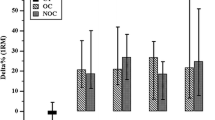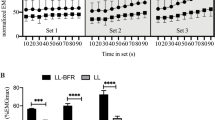Abstract
Purpose
In adults, low-load resistance training with blood flow occlusion (BFO) mimics strength increases that occur from high-load training, without the need to experience high mechanical stress. In view of child–adult differences in exercise responses, this study examined whether BFO during exercise elicits differential changes in maximal voluntary contraction (MVC) and electromyographical (EMG) activity in children and adults.
Methods
Sixteen men (24.4 ± 2.5 years) and 14 boys (10.7 ± 2.0 years) performed low-load resistance exercise (25 repetitions at 35% MVC) of the wrist flexors with and without BFO. MVC wrist flexor force and EMG activity of the flexor carpi radialis (FCR) were obtained at the beginning and end of the exercise.
Results
Both groups demonstrated a larger decrease in MVC force following BFO (− 18.6 ± 12.5%) than the control (without BFO) condition (− 6.2 ± 15.0%; p < 0.001). Whereas the men’s EMG amplitude increased 16.3 ± 20.5% (p = 0.005) during BFO, the boys’ EMG amplitude did not change over time or between conditions. In both groups, the mean power frequency (MPF) of the EMG signal decreased more during BFO (− 20.1 ± 9.6%; p < 0.001) than the control condition (− 5.6 ± 9.7%; p = 0.002).
Conclusions
Low-load exercise with BFO resulted in similar neuromuscular responses between boys and men, except for an observed increase in the EMG amplitude in men but not boys. While this result might suggest that men relied on a greater activation of higher-threshold motor units during BFO, it does not explain why there were similar decreases in MPF between groups. Therefore, it remains unclear whether the effectiveness of BFO training is similar for children and adults.






Similar content being viewed by others
Abbreviations
- BFO:
-
Blood flow occlusion
- EMG:
-
Electromyography
- MPF:
-
Mean power frequency
- MVC:
-
Maximal volitional contraction
- RE:
-
Resistance exercise
- RMS:
-
Root mean square
- RPE:
-
Rating of perceived exertion
References
Armatas V, Bassa E, Patikas D, Kitsas I, Zangelidis G, Kotzamanidis C (2010) Neuromuscular differences between men and prepubescent boys during a peak isometric knee extension intermittent fatigue test. Pediatr Exerc Sci 22(2):205–217. https://doi.org/10.1123/pes.22.2.205
Bouchant A, Abdelmoula A, Martin V, Lavet C, Williams CA, Ratel S (2012) Comparative analysis of quadriceps endurance during sustained submaximal isometric contractions in children and adults. In: Proceedings of the XXVIIth international symposium of the European group of pediatric work physiology, pp 91–95
Cook SB, Clark BC, Ploutz-Snyder LL (2007) Effects of exercise load and blood-flow restriction on skeletal muscle function. Med Sci Sports Exerc 39(10):1708–1713
Cook SB, Scott BR, Hayes KL, Murphy BG (2018) Neuromuscular adaptations to low-load blood flow restricted resistance training. J Sports Sci Med 17(1):66
Dotan R, Ohana S, Bediz C, Falk B (2003) Blood lactate disappearance dynamics in boys and men following exercise of similar and dissimilar peak-lactate concentrations. J Pediatric Endocrinol Metab. https://doi.org/10.1515/JPEM.2003.16.3.419
Dotan R, Mitchell C, Cohen R, Klentrou P, Gabriel D, Falk B (2012) Child—adult differences in muscle activation—a review. Pediatr Exerc Sci 24(1):2–21
Eriksson BO, Karlsson J, Saltin B (1971) Muscle metabolites during exercise in pubertal boys. Acta Paediatr 60(s217):154–157. https://doi.org/10.1111/j.1651-2227.1971.tb05717.x
Farina D, Merletti R, Enoka RM (2014) The extraction of neural strategies from the surface EMG: an update. J Appl Physiol (1985) 117(11):1215–1230
Godin G, Shephard RJ (1985) A simple method to assess exercise behavior in the community. Can J Appl Sport Sci 10(3):141–146
Halin P, Germain P, Bercier S, Kapitaniak B, Buttelli O (2003) Neuromuscular response of young boys versus men during sustained maximal contraction. Med Sci Sports Exerc 35(6):1042–1048
Hatzikotoulas K, Patikas D, Bassa E, Hadjileontiadis L, Koutedakis Y, Kotzamanidis C (2009) Submaximal fatigue and recovery in boys and men. Int J Sports Med 30(10):741–746. https://doi.org/10.1055/s-0029-1224171
Hatzikotoulas K, Patikas D, Ratel S, Bassa E, Kotzamanidis C (2014) Central and peripheral fatigability in boys and men during maximal contraction. Med Sci Sports Exerc 46(7):1326–1333. https://doi.org/10.1249/MSS.0000000000000239
Hebestreit H, Mimura K, Bar-Or O (1993) Recovery of muscle power after high-intensity short-term exercise: comparing boys and men. J Appl Physiol 74(6):2875–2880. https://doi.org/10.1152/jappl.1993.74.6.2875
Jansson E (1996) Age-related fiber type changes in human skeletal muscle. In: Maughan RJ, Shirreffs SM (eds) Biochemistry of exercise IX. Human Kinetics Publishers, Champaign, pp 297–307
Karabulut M, Abe T, Sato Y, Bemben MG (2010) The effects of low-intensity resistance training with vascular restriction on leg muscle strength in older men. Eur J Appl Physiol 108(1):147–155. https://doi.org/10.1007/s00421-009-1204-5
Lexell J, Sjöström M, Nordlund A-S, Taylor CC (1992) Growth and development of human muscle: a quantitative morphological study of whole vastus lateralis from childhood to adult age: growth and development of human muscle. Muscle Nerve 15(3):404–409. https://doi.org/10.1002/mus.880150323
Loenneke JP, Wilson GJ, Wilson JM (2010) A mechanistic approach to blood flow occlusion. Int J Sports Med 31(01):1–4. https://doi.org/10.1055/s-0029-1239499
Long D, Dotan R, Pitt B, McKinlay B, O’Brien TD, Tokuno C, Falk B (2017) The electromyographic threshold in girls and women. Pediatr Exerc Sci 29(1):84–93. https://doi.org/10.1123/pes.2016-0056
Manimmanakorn A, Hamlin MJ, Ross JJ, Taylor R, Manimmanakorn N (2013) Effects of low-load resistance training combined with blood flow restriction or hypoxia on muscle function and performance in netball athletes. J Sci Med Sport 16(4):337–342. https://doi.org/10.1016/j.jsams.2012.08.009
Manini TM, Clark BC (2009) Blood flow restricted exercise and skeletal muscle health. Exerc Sport Sci Rev 37(2):78–85. https://doi.org/10.1097/JES.0b013e31819c2e5c
Mirwald RL, Baxter-Jones AD, Bailey DA, Beunen GP (2002) An assessment of maturity from anthropometric measurements. Med Sci Sports Exerc 34(4):689–694
Moritani T, Sherman WM, Shibata M, Matsumoto T, Shinohara M (1992) Oxygen availability and motor unit activity in humans. Eur J Appl Physiol 64(6):552–556
Murphy JR, Button DC, Chaouachi A, Behm DG (2014) Prepubescent males are less susceptible to neuromuscular fatigue following resistance exercise. Eur J Appl Physiol 114(4):825–835. https://doi.org/10.1007/s00421-013-2809-2
O’Brien TD, Reeves ND, Baltzopoulos V, Jones DA, Maganaris CN (2010) In vivo measurements of muscle specific tension in adults and children. Exp Physiol 95(1):202–210. https://doi.org/10.1113/expphysiol.2009.048967
Paraschos I, Hassani A, Bassa E, Hatzikotoulas K, Patikas D, Kotzamanidis C (2007) Fatigue differences between adults and prepubertal males. Int J Sports Med 28(11):958
Person R, Golubovich K (1960) Electromyographic study of fatigue in man in conditions of artificial ischemia in the working muscle. Fiziologicheskii Zhurnal Sssr Imeni I. M Sechenova 46:1181–1187
Pitt B, Dotan R, Millar J, Long D, Tokuno C, O’Brien T, Falk B (2015) The electromyographic threshold in boys and men. Eur J Appl Physiol 115(6):1273–1281. https://doi.org/10.1007/s00421-015-3100-5
Ratel S, Bedu M, Hennegrave A, Doré E, Duché P (2002) Effects of age and recovery duration on peak power output during repeated cycling sprints. Int J Sports Med 23(6):397–402. https://doi.org/10.1055/s-2002-33737
Robertson RJ, Goss FL, Andreacci JL, Dube JJ, Rutkowski JJ, Frazee KM, Aaron DJ, Metz KF, Kowallis RA, Snee BM (2005) Validation of the children’s OMNI-resistance exercise scale of perceived exertion. Med Sci Sports Exerc 37(5):819–826
Takarada Y, Takazawa H, Sato Y, Takebayashi S, Tanaka Y, Ishii N (2000) Effects of resistance exercise combined with moderate vascular occlusion on muscular function in humans. J Appl Physiol 88(6):2097–2106. https://doi.org/10.1152/jappl.2000.88.6.2097
Tanner JM (1981) Growth and maturation during adolescence. Nutr Rev 39(2):43–55. https://doi.org/10.1111/j.1753-4887.1981.tb06734.x
Wernbom R, Aagaard P (2019) Muscle fibre activation and fatigue with low-load blood flow restricted resistance exercise—an integrative physiology review. Acta Physiol. https://doi.org/10.1111/apha.13302
Wernbom M, Paulsen G, Nilsen TS, Hisdal J, Raastad T (2012) Contractile function and sarcolemmal permeability after acute low-load resistance exercise with blood flow restriction. Eur J Appl Physiol 112(6):2051–2063. https://doi.org/10.1007/s00421-011-2172-0
Woods S, Dotan R, Jenicek N, Maynard J, Gabriel D, Tokuno C, Falk B (2019) Isometric-based test improves EMG-threshold determination in boys vs. men. Eur J Appl Physiol 119(9):1971–1979. https://doi.org/10.1007/s00421-019-04185-8
Woods S, Dotan R, Jenicek N, Falk B (2020) Isometric-based EMG threshold in girls and women. Eur J Appl Physiol 120(4):907–914. https://doi.org/10.1007/s00421-020-04331-7
Yasuda T, Brechue WF, Fujita T, Sato Y, Abe T (2008) Muscle activation during low-intensity muscle contractions with varying levels of external limb compression. J Sports Sci Med 7(4):467–474
Yasuda T, Brechue WF, Fujita T, Shirakawa J, Sato Y, Abe T (2009) Muscle activation during low-intensity muscle contractions with restricted blood flow. J Sports Sci 27(5):479–489. https://doi.org/10.1080/02640410802626567
Zafeiridis A, Dalamitros A, Dipla K, Manou V, Galanis N, Kellis S (2005) Recovery during high-intensity intermittent anaerobic exercise in boys teens, and men. Med Sci Sports Exerc 37(3):505–512. https://doi.org/10.1249/01.MSS.0000155394.76722.01
Acknowledgements
The authors wish to thank all participants for their hard work and dedication, as well as the parents or guardians for bringing the boys and making it all possible. We also thank Raffy Dotan for designing and building the isometric wrist flexion dynamometer, without which this study would not have been possible.
Funding
The study was supported by a Natural Sciences and Engineering Research Council (NSERC) Grant to CDT (RGPIN 2019-05851).
Author information
Authors and Affiliations
Contributions
AB, BF, DG and CT participated in the study’s design. AB and CA performed the testing. AB, BF and CT analyzed the data. AB, BF, DG, and CT interpreted the results. AB, BF, and CT drafted the manuscript. All authors edited and revised the manuscript. All authors read and approved the final version of manuscript.
Corresponding author
Ethics declarations
Conflict of interest
The authors declare that they have no competing interests.
Additional information
Communicated by Toshio Moritani.
Publisher's Note
Springer Nature remains neutral with regard to jurisdictional claims in published maps and institutional affiliations.
Rights and permissions
About this article
Cite this article
Bax, A.M., Amiaka, C.O., Falk, B. et al. The effect of acute low-load resistance exercise with the addition of blood flow occlusion on muscle function in boys and men. Eur J Appl Physiol 121, 2177–2185 (2021). https://doi.org/10.1007/s00421-021-04687-4
Received:
Accepted:
Published:
Issue Date:
DOI: https://doi.org/10.1007/s00421-021-04687-4




